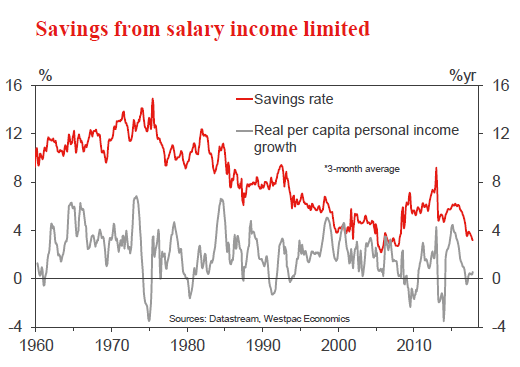Week beginning 18 December 2017
- Outlook for the economy supports rates on hold; China represents dominant risk.
- RBA minutes.
- Australia: mid-year Federal budget update, Westpac-MI Leading Index.
- NZ: GDP, business confidence, consumer confidence, current account.
- China: property prices.
- US: GDP 3rd estimate, PCE deflator.
- Central banks: BoJ policy decision.
- Key economic & financial forecasts.
Information contained in this report was current as at 15 December 2017.
Outlook for the Economy Supports Rates on Hold; China Represents Dominant Risk
As we contemplate 2018 and 2019 there are a number of key themes that we believe will dominate economic and market developments.
Our advice to customers throughout 2017 has been to expect Australia’s growth rate to be anchored below trend in both 2018 and 2019. That has contrasted with official forecasts (Reserve Bank) which anticipate growth picking up to 3.25% in both 2018 and 2019 while Commonwealth Treasury is forecasting growth nearer 3%.
We have recognised a solid ongoing boost to growth from nonresidential construction; government spending and exports. However we are much more downbeat than official forecasts on the consumer; residential construction and equipment investment.
Slowing household incomes
Signals from the September quarter national accounts are not encouraging for the official view. There is some evidence that households are reassessing prospects for income growth, particularly with respect to a lift in wages growth. Ongoing positive expectations for a boost in income growth have encouraged households to cut their savings rate from 7.5% in 2013 to 3.2% in September 2017 (up from 3.0% in June).
We believe that household labour income growth will ease again in 2018 as wages growth remains benign and hours worked start to slow. Households which are also constrained by high debt and high energy prices are unlikely to be able to lift spending to allow the official growth forecasts to be reached.
Housing downturn
Resulting below trend consumption growth will also discourage any recovery in equipment investment. Residential housing and alterations and additions have also started to slow and, based on the downturn in high rise approvals, we expect this downturn has further to run. Large increases in supply and a marked slowdown in sales to foreigners are weighing on the outlook for residential building.
House price inflation is disappearing. On a six month annualised basis prices are now falling in Sydney and Perth while price gains are slowing in Melbourne, Brisbane and Adelaide.
The regulator’s macroprudential policies are restricting interest only loans and tighter guidelines for all new loans are slowing house price inflation and credit growth. We expect housing credit growth to slow from 6.5% in 2017 to 5% in 2018 and 4.5% in 2019.
In previous cycles the authorities have relied on raising interest rates to slow the highly cyclical housing market. This time, the same effect has been achieved by the regulator as banks have independently raised loan rates, with the downturn in foreign demand also weighing on activity.
Inflation below target
Inflation is expected to remain benign holding a little below the bottom of the Reserve Bank’s 2-3% target band. In this regard we are in agreement with the Reserve Bank which is forecasting that underlying inflation will hold at 1.75% in 2018 before lifting modestly to 2% in 2019.
Under these circumstances we can not fall into line with most other economists who continue to anticipate that the Reserve Bank will begin to raise rates in 2018. Indeed we have been of the view through 2017 that the official cash rate will remain on hold in both 2018 and 2019.
With rates on hold in Australia and the US Federal Reserve continuing to raise rates, Australia’s cash rate is set to fall below the Federal funds rate by mid-2018.
Sustained period of negative Aus-US rate spreads
The US economy is operating with much less ‘slack’ in its labour market (unemployment rate of 4.1% compared to a estimated full employment rate of 4.75%) than Australia (unemployment rate of 5.5% compared to a full employment rate of 5.0%) but little wage pressure has emerged. Over the course of 2017 the USD has fallen by around 8% despite four rate hikes since December. With financial conditions also easing via a 20% rally in the US equity market, the Fed has seized on the opportunity to raise rates in anticipation of rising inflation. Without access to an effective macro-prudential policy (due to the highly regionalised and low concentration of lenders in the market) it has relied on higher rates to deal with the threat of financial instability.
We expect that process to continue in 2018 with two more 25 basis point hikes in June and December. That would see the AUD/USD yield differential in the overnight market contract to minus 38 basis points – a situation we have not seen early 2000. A heavy toll will be taken on the AUD with the currency forecast to fall to USD 0.70 by the end of 2018.
With upward pressure on the USD in 2018 and inflation remaining benign we expect that the Fed will hold rates steady through 2019 ensuring that the negative yield differential with Australia holds through 2019 and that the AUD will fall further. We expect a move down to USD 0.68 in 2019, with downside risks.
Heightened period of political uncertainty
Political uncertainty will remain a feature of the Australian economic picture in 2018 and 2019. The government is likely to embrace expansionary policies, particularly around tax, and may be prepared to compromise the proposed 2021 budget surplus to achieve a more constructive fiscal stance.
Coupled with the boost from a much lower Australian dollar, markets will eventually start to sense an improved growth outlook for Australia and even begin to anticipate higher overnight cash rates in 2020 following the 2019 election. Bond markets and the AUD will respond.
Global risks
The two major global risks for 2018 and 2019 centre around the US share market and the Chinese financial system.
The US share market has risen by over 20% over the last year or so. Pundits have been labelling this lift as a potential bubble. But earnings growth and the interest rate outlook are not severely out of line with current valuations. Share market collapses are generally triggered by sharp increases in bond rates. Such an increase would be in response to a significant upgrading in inflation and growth prospects. Westpac expects a reasonably benign path for inflation in the US through 2018 prompting the Fed to raise rates by 50 basis points and pushing the 10 year bond rate to 3% – not a sufficient enough move to trigger an equity market collapse. Furthermore, we expect the Fed to remain on hold in 2019 as policy in other major jurisdictions ‘catches up’ and the balance sheet gradually contracts. The more markets fear the sell off and the more cautious the rally becomes the more sustainable it is likely to be.
On the other hand the uncertainties and risks around the Chinese financial system are daunting.
Much has been made of the synchronised lift in global growth in 2017. From Australia’s perspective, the key development has been the faster than anticipated growth in China. We expect China’s growth rate will reach a comfortable 6.8% in 2017 but anticipate a decent slowdown in 2018, to 6.2%.
The Week that Was
The past week has proven particularly interesting. Following weeks of disappointing data, Australia received two significant upside surprises. Offshore, central banks were in focus.
The highlight of the week was the November employment report. We and the market were expecting another solid result circa 20k. In the event, the ABS reported an outcome more than three times as large, +62k, with full-time employment the primary contributor. Intriguingly, the unemployment rate was unchanged in the month at 5.4% as the participation rate rose 0.3ppts. This combination points to sample rotation being behind the jump. Regardless, this is still a strong update, being the 14th positive outcome and seeing annual growth at 3.2%, twice population growth. A partial reversal is likely in coming months but, based on the leading indicators, employment growth should remain robust into 2018.
The Westpac-MI Consumer Sentiment index also surprised to the upside in December, printing at 103. Continued strength in the labour market and tempered expectations of a rate hike likely aided confidence. Global growth and the positive impetus they have provided to equity markets was also supportive. Notably though, concerns around housing affordability remain front and centre, particularly in Sydney and Melbourne. Responses to the ‘wisest place for savings’ question also remain highly risk averse. Given high levels of household debt; soft wages growth; and rapid increases in the cost of life essentials, it seems unlikely that consumption growth will be driven higher as the RBA expect.
In addition to these two primary releases, this week also saw the latest update for the NAB business survey. In November, conditions remained above-average despite more than reversing October’s spike. Confidence also deteriorated, but is still in line with the long-run average. Strength was also seen in our Q4 Australian Chamber Westpac Survey of Industrial Trends. These surveys point to strength in employment growth being sustained into 2018 as well as for a sustained uplift in investment.
Before turning to the global economy, it is worth noting that Monday coming will see the release of the Australian Federal Government’s mid-year update. Our preview highlights that, unlike most of the post-GFC period, the update will be favourable. See preview box ahead for further detail.
In NZ, the new government has provided their first fiscal update, in which they took quite an optimistic view on the outlook. Our NZ team sees downside risks to the Government’s growth forecasts and therefore to tax receipts and the bottom line.
For the US, there are three events worthy of discussion. First is the December FOMC meeting. Here the Committee delivered a 25bp rate hike as expected and showed greater confidence in the growth outlook – owing to firming expectations around tax reform as well as recent robust momentum. However, they continue to believe that inflation is set to remain below or at target throughout the forecast period. As a consequence, the FOMC’s interest rate expectations were left unchanged.
The other two developments relate to Washington. The Alabama Senate election saw Democrat Doug Jones win. That means the Republican majority in the Senate is now just one. Unsurprisingly, this has seen Congressional Republicans push for a quick passing of the now-agreed joint tax package – before Doug Jones is admitted. However, that doesn’t necessarily mean that there won’t be hold outs. To date, Republican Senators Rubio and Collins have voiced concern. It also bears remembering that the current two-week spending authority granted will end in seven days, again raising the risk of a government shut down.
Caution was also on display at the European Central Bank and Bank of England December meetings. As occurred in the US, the ECB upgraded their growth view, but held back on inflation. Weakness in wages is a key factor here. We look for the ECB to step purchases down to a EUR15bn pace in Q4 2018 and then to end purchases for 2019. Increases in the benchmark refinance rate will be a long time coming. The Bank of England is closer to raising rates than the ECB currently; however, justification for doing so is very limited, and the downside risks are substantial.
Finally, we highlight some summer reading. The December/ January edition of Market Outlook has just been released. In it, a number of key themes are discussed, most notably China’s financial system and Amazon’s Australia entry. Having looked backed at the ‘year that was’, Chief Economist Bill Evans considers 2018 outlook for the Australian and global economy.
Chart of the week: Unemployment and underemployment
Total employment rose 61.6k compared the market’s 19k forecast and Westpac’s +25k. In the month unemployment was flat at 5.4% (5.40% at two decimal places vs. 5.39% in Oct) with a 0.3ppt gain participation driving 65.7k surge in the labour force.
A further positive is the decline in the underemployment from 8.5% in Aug to 8.3% in Nov (the seasonally adjusted estimate is only released quarterly). This is indicative of an overall improvement in the labour market and possible upwards pressure in wages. However, at this stage we are yet to see any significant increase in wage inflation and underemployment continues to lag the improvement in the unemployment rate and the surge in hours worked.
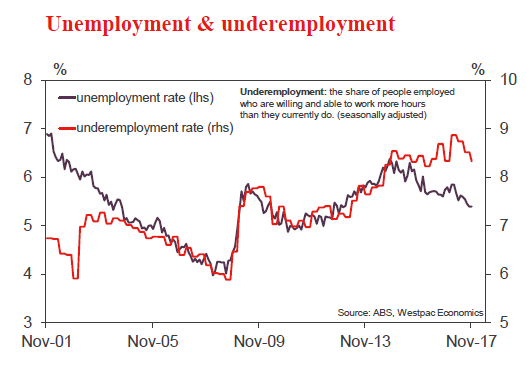
New Zealand: Week Ahead & Data Wrap
Growth slowdown under way
The past year has seen some big changes in the economic landscape, and further changes are on the cards over 2018. So as this year draws to a close, how is the New Zealand economy tracking, and what can we expect going forward?
How strong is the New Zealand economy looking?
Next week’s GDP report is expected to show that economic growth slowed to just 0.4% through the September quarter. In part, this slowdown reflects the impact of some temporary factors. Poor weather through the middle part of the year put a dampener on agricultural production. We’ve also seen earlier boosts to demand in the tourism and hospitality sectors fading following high profile sporting events in the first half of 2017.
However, even smoothing through those temporary disruptions, the New Zealand economy has lost some steam. We expect that GDP growth over 2017 as a whole will come in at just 2.4%. That’s down from 3% over 2016. And after adjusting for rapid population growth over the past year, we’re left with a picture of relatively flat per capita economic growth.
But while the pace of overall growth has eased off, the final months of the year have seen signs of resilience in some key parts of the economy. Most notably, the housing market has found a new (though likely temporary) lease on life, with house sales posting solid gains through October and November. We’ve also seen a re-acceleration in house price inflation in parts of the country including Auckland. Importantly, this resurgence in the housing market appears to have also given spending a shot in the arm, with electronic cards transactions rising by more than expected in November.
Increasing headwinds expected over 2018
This resilience in activity late in 2017 is important, as it leaves the economy on a firmer footing as we enter what’s shaping up to be a testing year. As we’ve been highlighting in recent weeks, headwinds for growth have been mounting. Among the more notable developments has been the downturn in net migration, which we expect to continue for some time and which will weigh on economic growth. At the same time, construction activity has flattened off in the face of difficulties sourcing finance, challenges accessing skilled labour, and rising costs.
And of course, on top of those factors we’re looking at significant changes in the policy environment over the coming years. That includes the coming introduction of a suite of policies that will dampen the housing market, and which will likely have flow-on downside impacts for consumption spending.
The above factors mean that GDP growth is likely to remain fairly modest over the coming year. We’re forecasting economic output will rise by only 2.4% over calendar 2018.
Our forecast for subdued economic growth over the coming year are in stark contrast to forecasts in the Government’s Half Year Economic and Fiscal Update (HYEFU), released this past week. That update provided us with our first detailed look at how the new coalition Government expects its policies will affect the economy. However, digging though the details of the HYEFU, we think the Government is being far too optimistic about the outlook over the next few years. In particular, the HYEFU forecast assumes an acceleration in GDP growth to 3.5% over 2018, underpinned by firmness in both investment spending and household consumption. Both of those assumptions look doubtful to us. As well as the downside risks for the housing market and household spending highlighted above, businesses we’ve spoken with in recent weeks have told us that they are extremely nervous about the outlook. We expect that this will be a significant drag on investment spending and hiring over the coming year.
If GDP growth doesn’t accelerate to the extent that the Treasury is projecting, the risk is that future revenue will fall short, requiring the Government to either rein in some of its spending plans, find additional sources of revenue, or abandon its commitment to reducing net debt so rapidly. This vulnerability isn’t unique to the new Government: we made similar comments at the time of the May Budget. And since our point of disagreement relates to the outlook for economic growth several years ahead, it’s likely that our concerns will remain for some time.
New year, new Governor
One of the lingering uncertainties about the economic outlook has been the potential impact of looming changes at the RBNZ. The most important question on this front is how policy will respond to the planned expansion of the RBNZ objectives to include a focus on employment.
We’ve been wary of the dual mandate as it might make it harder for the Reserve Bank of raise rates when inflation is too high, since that could conflict with a directive to maximise employment.
However, some of that uncertainty around the outlook for monetary policy has dissipated following the announcement that Adrian Orr will take over as RBNZ Governor in March. Mr Orr is currently the head of the NZ Super Fund. He has previously held senior roles at the RBNZ and was Chief Economist at Westpac. With his extensive experience in economic policy, we would expect that the RBNZ will remain realistic about what impact monetary policy can have on the economy in the long run, while still focusing on employment over the economic cycle.
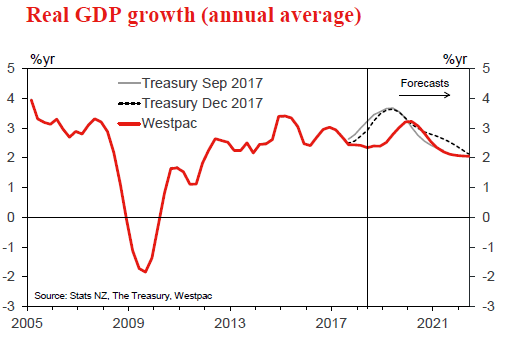
Data Previews
Aus Federal budget, 2017/18 mid-year update, AUDbn
Dec 18, Last: -29.4 (pr), WBC f/c: -27
Mkt f/c: tba, Range: tba
- The Federal Government’s Mid-Year Economic and Fiscal Outlook is expected to confirm the broad profile for the budget balance, as set out in the May Budget.
- On the economy: forecast nominal GDP growth for 2017/18 is likely to be upgraded to 4.5% from 4.0% at Budget time, on upside to commodity prices; while real GDP growth is on track for the forecast 2.75%. For the out years, the economic forecasts are likely to be little changed.
- The stronger starting position for the economy boosts revenues, while a likely small undershoot on expenditures could be used to fund modest new initiatives.
- On our figuring, the forecast budget deficit for 2017/18 is $2.4bn smaller, at $27.0bn vs $29.4bn at budget time.
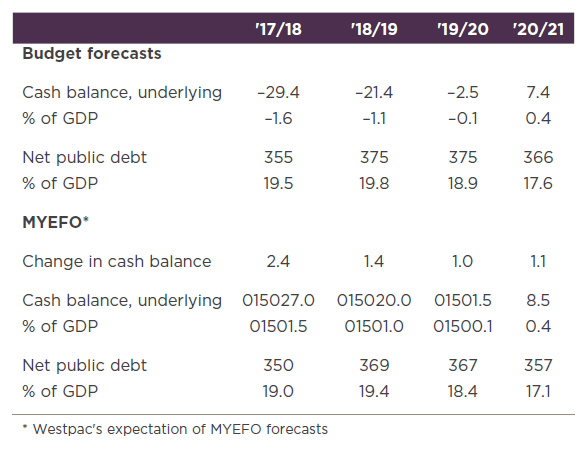
Aus Oct Westpac-MI Leading Index
Dec 20, Last: +0.44%
- The six month annualised growth rate in the Leading Index lifted from -0.02% in September to +0.44% in October, marking the first above trend reading on momentum since mid-year and suggesting some of the headwinds to growth evident earlier in 2017 have eased.
- The Nov index will include mostly positive component updates including: the Westpac-MI Consumer Expectations Index, up 3.4% vs -1.8% last month; commodity prices, up 2.2% in AUD terms vs -0.4% last month; the Westpac-MI Unemployment Expectations Index, down -2.4% vs 1.2% last month (declines mean an improved read); and total hours worked, up 0.6% vs 0.3% last month.

NZ Q4 Westpac McDermott Miller Consumer Confidence
Dec 19, Last: 112.4
- The Westpac McDermott Miller Consumer Confidence survey softened to a level of 112.4 in September, down from 113.4 in June. Given normal quarter-to-quarter volatility, that was a fairly small decline. And following gains earlier in the year, it left household confidence at firm levels.
- The December survey will provide an update on how consumer confidence has fared following the election of the new Government and related changes in the outlook for economic policy.
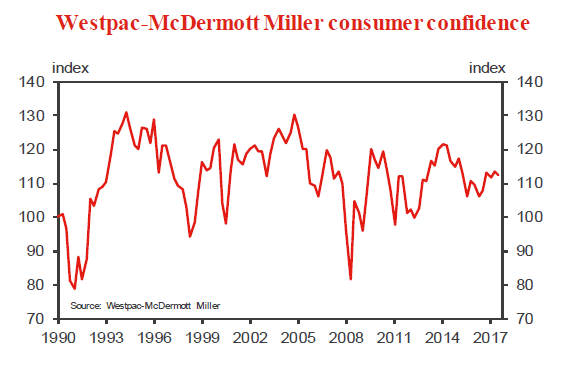
NZ Dec business confidence
Dec 19, Last: -39.3
- Business confidence plunged in November, falling to its lowest level in nine years. Some of the drop was likely a knee-jerk reaction to the change of government – we find that business confidence averages about 20 points lower under left-wing governments. However, the November drop was even larger than this, and confidence has been falling since July.
- While the fall in confidence may prove to be an overreaction, expectations do matter. Our forecasts include a hiatus in business investment in 2018, one of the reasons why we expect subdued GDP growth next year.
- Inflation expectations rose sharply in November, presumably on a view that the new Government will be inflationary. We agree with that view over the long term, but not the one-year ahead horizon that the survey covers – in fact, the balance of Government policies is likely to reduce inflation over 2018.

NZ Q3 current account, % of GDP
Dec 20, Last: -2.8%, Westpac f/c: -2.5%, Mkt f/c: -2.5%
- We expect the annual current account deficit to narrow to 2.5% of GDP in the September quarter. Part of the improvement is due to base effects, with dairy export prices and volumes higher than they were a year earlier.
- For the quarter, goods exports were steady, while import prices and volumes fell. Services exports dropped back from the previous quarter’s rise, when tourism was boosted by the Lions rugby tour.
- We expect the investment income deficit to widen, due to higher profits for overseas-owned firms.
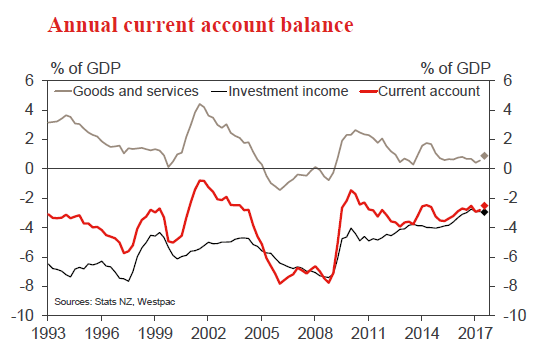
NZ Q3 GDP
Dec 21, Last: 0.8%, Westpac f/c: 0.4%, Mkt f/c: 0.6%
- We expect a subdued 0.4% rise in GDP for the September quarter. Much of the expected weakness is due to lower primary sector activity. Milk production made a slow start to the new season, and oil and gas extraction has continued its natural decline.
- On the positive side, we expect strong contributions from non-food manufacturing, construction and personal services.
- The September quarter is likely to mark the low point for growth this year. The June quarter benefited from a pickup in milk production and a spike in tourist numbers during the Lions rugby tour. Similarly, we expect some rebound in December quarter growth, with a number of near-term indicators showing signs of life.
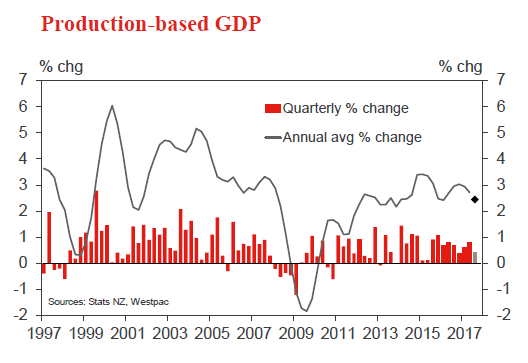
US Dec Personal income and spending
Dec 22, personal income, last 0.4%, WBC 0.4%
Dec 22, personal spending, last 0.3%, WBC 0.5%
Dec 22, personal deflator, last 0.1%, WBC 0.3%
- Despite very strong employment growth which has seen both the unemployment rate and underutilisation decline rapidly, wages growth in the US remains subdued. Indeed, on a real discretionary basis, household incomes are up only around 0.5%yr. It is therefore unsurprising that the savings rate has been falling.
- While sentiment has also been supportive, the budget reality that households face is restricting spending, which slowed in the September quarter and remained subdued in October. We expect November might see a bounce in services, but risks are to the downside.
- Inflation remains well contained. The core CPI disappointed expectations in Nov, +0.1% and the PCE variant is likely to follow suit. Energy will add in November.
